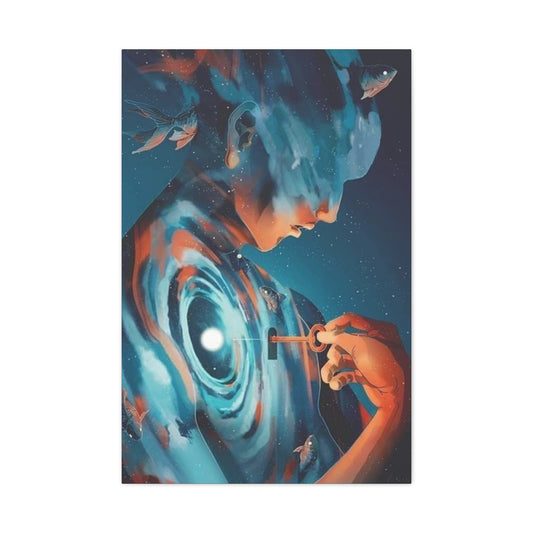Reimagining Mental Health Spaces: The Power of Art in Healing Environments
In today’s evolving understanding of mental health, the environments in which people receive care are no longer viewed as neutral backdrops. Increasingly, the design and emotional character of these spaces are recognized as active participants in the healing journey. This shift in perspective underscores the mission of Hospital Rooms, a visionary charity that seeks to revolutionize mental health facilities through the infusion of contemporary art. Their mission is rooted in a simple yet profound belief: spaces designed with empathy and creative intention can profoundly impact the mental and emotional well-being of those within them.
Hospital Rooms doesn’t merely add art to walls; it reinvents the relationship between space, care, and creativity. Traditional hospital settings, especially in mental health wards, often suffer from sterile aesthetics. They are designed for efficiency and safety, often at the expense of emotional warmth and personal connection. Hospital Rooms confronts this challenge head-on by inviting internationally renowned artists to work directly with patients and staff in transforming these spaces into vibrant, emotionally resonant environments.
At the heart of this transformation is a collaborative process unlike any typical commissioning model. Artists are not briefed from afar or instructed to produce generic works. Instead, they are immersed in the daily lives of the wards they will help transform. These artists spend time listening to patients’ stories, understanding their journeys, and absorbing the atmosphere of the spaces they will influence. Through this deeply participatory approach, art becomes more than decoration, becoming a co-created experience that reflects the shared humanity of both creators and viewers.
This model of integration between creative professionals and care communities not only respects but elevates the lived experiences of service users. It ensures that the resulting installations are not just visually compelling, but emotionally anchored in the reality of those who will encounter them every day. From murals that evoke memory and nostalgia to abstract pieces that invite introspection and peace, the diversity of installations mirrors the diversity of emotional needs found in mental health settings.
The Collaborative Spirit: Artists, Patients, and the Creation of Healing Spaces
One of the most groundbreaking elements of the Hospital Rooms initiative is its commitment to inclusive artistic engagement. In a typical healthcare setting, design decisions are made top-down, often by architects or administrators with limited insight into the psychological effects of aesthetics. In contrast, Hospital Rooms upends this hierarchy by placing artists side by side with patients, clinicians, and caregivers in the creative process.
This collaborative model transforms the act of creation into a therapeutic encounter itself. Patients are not just recipients of beauty; they become active participants in shaping it. Through workshops, dialogue sessions, and hands-on contributions, they find opportunities to express themselves in ways that bypass the limitations of language. In doing so, the process becomes as healing as the product.
Take, for example, painter Sutapa Biswas and her mural at Highgate Mental Health Centre. Drawing from intimate conversations with female patients about their childhoods and personal geographies, Biswas created a lush botanical mural that transports viewers to places of safety and memory. The Women’s Quiet Room where it resides becomes not just a physical space but a portal to solace and reflection, where color and form reawaken dormant joy and cultural connection.
Another powerful example is the work of Yukako Shibata, whose ethereal mural transformed a small sitting area into an abstract sanctuary. Using subtle layers and translucent hues, Shibata’s piece evokes feelings of calm, renewal, and introspective clarity. Because it doesn’t dictate a specific narrative, each viewer brings their own interpretation, allowing personal memories, thoughts, and emotions to surface in gentle, affirming ways.
Mark Titchner’s project at the Snowsfields Adolescent Unit highlights another facet of this inclusive approach: verbal expression. Through workshops with young residents, Titchner helped generate affirmational phrases rooted in the voices of the participants themselves. These wordshopeful, daring, and deeply personalbecame the foundation for a vibrant mural that now serves as a daily reminder of resilience and aspiration.
This dialogical process transforms the relationship between patient and space. What once may have felt like a place of confinement or detachment becomes a canvas of expression and empowerment. The presence of one’s own story within the environment acts as a powerful affirmation of worth and agency.
Art as Emotional Architecture: Healing Beyond the Clinical
The true genius of Hospital Rooms lies not only in its artistic excellence but in its understanding of emotional architecture idea that spaces can be constructed with care, compassion, and psychological insight. This is not simply about making hospitals more attractive. It’s about making them feel like places where human dignity is preserved, where emotional experiences are acknowledged, and where healing becomes a multisensory, holistic process.
Artists working within this initiative are challenged to consider the complex emotional states of those who will inhabit their work. They must think beyond composition and technique to understand how their creations will be perceived by individuals in crisis. Every line, texture, and shade must be approached with sensitivity. What might evoke serenity for one person could trigger distress in another. This balancing act demands a deep understanding of human psychology, a readiness to listen, and an intuitive sense of emotional design.
Hospital Rooms also demonstrates that therapeutic space is not a singular concept is layered and diverse, just like the people it serves. Some rooms need to calm heightened anxiety; others aim to uplift the spirit or facilitate moments of reflection. Artists are encouraged to adapt their mediums and methods to meet the unique energy of each location. The result is a rich tapestry of interventions that respond authentically to the needs of different populations.
Moreover, the inclusion of contemporary, often conceptual, art forms invites viewers to engage intellectually and emotionally. This is not the tokenistic artwork often found in public institutions. These are original, often site-specific works that challenge viewers to think, feel, and connect. For many patients, especially those in long-term care, this interaction becomes a rare and meaningful moment of cultural engagement with something unexpected, inspiring, and profoundly human.
The work of artists like Gavin Turk, Julian Opie, Tschabalala Self, and Nengi Omuku brings further dimension to the initiative. Their distinct voices and varied practices underscore the universality of art’s appeal while also highlighting its capacity to speak to individual journeys. Whether through bold abstraction, figurative narratives, or text-based affirmations, each artist contributes a unique note to the symphony of visual care being conducted across these hospitals.
The impact of these transformations extends far beyond aesthetics. Clinical staff have reported positive changes in patient mood, interaction, and even recovery trajectories. Visitors feel more welcomed, and patients often express pride in their surroundings. This sense of ownership and beauty becomes a daily affirmation of self-worth, challenging the stigmas that so often accompany mental health care.
In a world increasingly attuned to the importance of mental wellness, Hospital Rooms stands out as a model for how creativity can be harnessed for the collective good. It shows us that healing doesn’t only happen through medicine or therapy sessions, but through every element of our environmentincluding the images we see, the spaces we occupy, and the stories we are surrounded by.
The journey of Hospital Rooms is ultimately a journey toward rehumanizing healthcare. By placing authentic, intentional artwork at the heart of mental health spaces, this initiative invites us to rethink what care looks and feels like. It offers a vision of healthcare where art and empathy walk hand in hand, where rooms become refuges, and where every wall has the potential to speak, soothe, and heal.
The Art of Listening: Where Healing Begins
True transformation within mental health spaces doesn’t begin with color palettes or design briefs starts with listening. At the heart of Hospital Rooms’ innovative work is the profound act of bearing witness to personal stories, emotions, and silent longings. Artists invited into psychiatric hospitals don’t arrive with predetermined visions. Instead, they step into these often-overlooked spaces with open minds and compassionate curiosity. Their first role is not as creators, but as observers and listeners.
This unique approach ensures that the environments they help shape are not simply decorative but deeply resonant. The dialogue between artists and service users is not a procedural formality but the very soul of the creative process. Artists immerse themselves in the rhythms of the wards, walking hallways, sitting in quiet rooms, and absorbing the sensory layers of the space. They take note of the subtle detailsechoes in the corridors, how light shifts throughout the day, the emotional temperature of each room.
Crucially, these initial exchanges are not about diagnosis or therapy in the traditional sense, but about establishing trust and uncovering the emotional truths of each setting. Through unstructured conversations and storytelling sessions, artists gain access to a rich tapestry of experiences. Service users are encouraged to share what the space means to what memories it holds, what makes them feel safe, what brings discomfort, and what they yearn to see.
One of the most powerful manifestations of this process unfolded at the Garnet Ward of Highgate Mental Health Centre, where renowned artist Sutapa Biswas initiated her creative journey not with a design proposal but with an invitation to reminisce. Residents were asked to share cherished memories of places that offered them peace, joy, or comfort. These stories ranged from vivid recollections of ancestral homes and sun-drenched gardens to childhood hideaways shaded by tropical trees. Rather than abstract these tales into impersonal motifs, Sutapa translated them directly into a panoramic mural intricate garden teeming with botanical imagery from around the globe. The final artwork transformed the ward into a lush sanctuary, a collective memory rendered visible and vibrant, embodying a sense of shared belonging.
This collaborative spirit also defined the work of artist Yukako Shibata. In her interactions with residents, she shared early iterations of her conceptsubtle abstract compositions with translucent layers and gentle color gradations. These pieces did not dictate meaning; they invited interpretation. The responses from service users were profound. They described the works using metaphors drawn from the sacred and the serene: chapel light, ocean mist, an open sky. Embracing these reactions, Yukako deepened the ambiguity of her final composition. Her mural offered no singular focal point but instead created a space of fluid perception, allowing individuals to find their resonance within the work. The result was not only visually soothing but emotionally expansive, enabling each viewer to inhabit the piece on their terms.
Co-creation in Practice: Workshops as Portals to Agency
Hospital Rooms recognizes that healing is not a passive experience. True therapeutic engagement involves agency, choice, and creative expression. That is why workshops form a central pillar of every project. These sessions are not about teaching art or filling time, they are about opening doorways for self-expression and turning service users into co-authors of their environments.
Within these workshops, seemingly simple actsdrawing a shape, sharing a phrase, and selecting a texturecarry profound significance. They allow participants to externalize feelings that may otherwise remain unspoken. The creative process becomes a mirror through which inner worlds are acknowledged and given form. Moreover, the materials created during these sessions often become integral to the final installations. In this way, every finished artwork reflects not just the artist’s skill but the psychological landscape of those it is designed to support.
This ethos was powerfully embodied in the work of Mark Titchner at the Snowsfields Adolescent Unit. Titchner’s approach centered on language as a source of empowerment. Through a series of workshops, he encouraged young people to articulate affirmation phrases that reflected their hopes, their struggles, and their resilience. These weren’t generic slogans; they were raw, personal expressions of belief in the face of uncertainty. Out of these sessions emerged the now-iconic mural emblazoned with the words "Believe Dreams." Set against a bold, ornamental background, the piece transforms the wall into a beacon of possibility. For the adolescents navigating complex emotional terrain, this artwork stands as both a mirror and a mantra.
Similarly, at Bluebell Lodge, the power of participatory design reached new heights. Artist and Hospital Rooms co-founder Tim A Shaw introduced miniature architectural models of the ward during his workshops. These models served as tools for experimentation, enabling residents to explore different textures, colors, and compositions before committing to a final design. This hands-on process gave participants a sense of ownership over their environment. Together, they arrived at a concept featuring silver clouds drifting across a cerulean sky. Now painted across the Dining Room ceiling and hallways, these shimmering clouds shift subtly throughout the day, playing with light and shadow. The result is a dreamscape that evokes calm and renewal metaphorical sky under which new narratives can unfold.
The iterative nature of these projects ensures that feedback remains central from conception to completion. Artists frequently return with mock-ups, sketches, and sample materials, inviting continued input. This ongoing dialogue allows designs to evolve in alignment with the shifting perspectives and emotional needs of the community. It also deepens the bond between artist and audience, reinforcing that this is not art done to people, but art created with them.
Material Meaning: Aesthetic Integrity Meets Emotional Intelligence
In mental health settings, every surface tells a story. The choice of materials is never arbitrary; it is an ethical decision that balances safety, durability, sensory impact, and emotional resonance. Hospital Rooms embraces this complexity, often collaborating with experts in material science to ensure that every elementpaint, texture, finishenhances the environment without compromising on care.
Surfaces are chosen not just for their appearance, but for how they feel under the hand, how they reflect light, and how they might comfort or stimulate someone in distress. Can a wall invite tactile curiosity without posing a safety risk? Can color soothe without dulling? These questions are not theoreticalthey are asked in real time, in collaboration with those who inhabit the space.
One artist who exemplified this sensitivity was Michael O’Reilly, scenic painter for the Royal Opera House. For his work at Garnet Ward, O’Reilly drew inspiration from his own family’s experiences, particularly his grandmother’s deep appreciation for stained glass during her time in the hospital. With this emotional memory as a guide, he created a mural that echoed the luminosity and warmth of stained glass windows. The woodland scene he painted featured golden leaves, flickering firelight, a curious cat, and a humble beehive. These elements were not just decorativethey were carefully chosen symbols of comfort, domesticity, and curiosity.
The mural also prioritized accessibility. Its bold outlines and high-contrast colors ensured visibility for those with visual impairments, while its layered imagery invited prolonged contemplation. This was not an artwork that revealed itself at once. It invited viewers to return, again and again, to notice something new rising trail of smoke, the gleam of sunlight through a treetop, the hidden playfulness of a forest creature. In doing so, it encouraged moments of quiet engagement, offering both cognitive stimulation and emotional refuge.
The broader philosophy behind such work is simple yet revolutionary: that art can be a form of care. In clinical environments often defined by uniformity, surveillance, and sterility, bespoke art reintroduces individuality and beauty. These spaces do not offer escape from reality, but a more compassionate version of itone in which the emotional intelligence of the environment is attuned to the people within it.
Through this fusion of creativity and care, Hospital Rooms challenges the notion that mental health facilities must be impersonal or utilitarian. Instead, they become sanctuaries of humanity. The murals, installations, and design interventions do not merely adorn wallsthey become part of the lived experience of recovery. They hold stories, offer comfort, spark imagination, and most importantly, return a sense of dignity to those who have often been marginalized by the very systems meant to support them.
The success of these efforts isn’t measured in awards or press coverage. It is found in the daily, quiet victories: a resident who lingers longer in a room they once avoided, a clinician who feels emotionally supported by the environment, a family member who sees their loved one momentarily transported by color and form. These are the alchemical moments where collaboration, empathy, and creativity combine to transform space, not just physically, but spiritually.
Art as a Catalyst for Empowerment and Healing in Psychiatric Spaces
At the heart of every Hospital Rooms initiative lies a powerful mechanism for change: artist-led workshops. These aren’t auxiliary features of the projectthey are the very soul of it. Far beyond simply decorating hospital walls, these creative gatherings open the door to transformation by reimagining how patients and staff relate to their environment, their diagnosis, and themselves. Within the framework of mental health care, often marked by rigidity and routine, these workshops cultivate a new rhythm grounded in collaboration, expression, and personal agency.
Hospital wards, by their nature, can foster a sense of detachment and depersonalization. The clinical atmosphere, while essential for treatment, often strips individuals of their autonomy and expressive freedom. This is where the workshops become radically transformative. They offer an alternative space sanctuary of creativity where those receiving care are invited to become co-authors of their surroundings. Here, individuals are no longer seen merely through the lens of diagnosis. They are artists, visionaries, and storytellers, encouraged to engage with materials, shapes, and ideas in a nurturing and non-judgmental setting.
This shift is not just theoretical. The emotional and psychological effects can be witnessed in real time: a hesitant resident gradually finding their voice, a staff member rediscovering joy in paint and paper, or a quiet adolescent composing words that echo with unexpected depth. The workshops are structured yet fluid, intentional but open-ended. They allow for moments of surprise, for discoveries that cannot be planned, and for personal narratives to surface and be validated.
One striking example is the work of artist Mark Titchner at the Snowsfields Adolescent Unit. He approached the young service users not with directives, but with a willingness to listen. Through a series of workshops, participants were invited to craft short affirmations and phrases that emerged from their own experiences of resilience, hope, and aspiration. These affirmations, such as "Believe Dreams," were not just acts of expression but proclamations of identity. Titchner then embedded these words into a large-scale mural, turning the family room into a powerful monument of youthful strength. It was not merely decorative was a mirror reflecting the courage and creativity of those who contributed to it.
Collaborative Creation: Transforming Spaces Through Shared Vision
The collaborative nature of these workshops extends far beyond their therapeutic implications. They also serve a crucial design function within the broader project. The ideas, choices, and contributions gathered during these sessions become the blueprint for the final artworks. At Bluebell Lodge, for instance, artist Tim A Shaw led a series of exploratory model-making sessions with residents. These miniatures became testbeds for visual ideascolor schemes, compositional flows, and symbolic elements. Through this iterative design dialogue, participants were not just consultedthey were integral to the artistic process.
The resulting mural, a celestial expanse of silver clouds, was not a unilateral vision imposed upon the space but a visual chorus of shared insights. Its ambient calm and subtle beauty emerged from the emotional and aesthetic preferences of the community itself. It speaks not just to the eye, but to the heart, resonating with those who helped shape it.
For older adults, particularly those experiencing cognitive decline, the workshops offer something equally profound. In settings such as Garnet Ward, artist Sutapa Biswas designed her sessions around the evocative power of memory. Participants were encouraged to recall gardens they once tended, the fragrance of blossoms from their childhood, and cherished scenes from family homes. These tender recollections were not merely spokenthey became brushstrokes in a larger visual narrative. The final mural, sprawling, dreamlike gardenwas rich with emotional subtext. It wasn’t just a painting on a wall; it was a collective memoryscape, a tribute to lived experience rendered visible.
These projects demonstrate that artistic engagement does not require technical skill or training. Rather, it requires presence, curiosity, and willingness to connect. Yukako Shibata’s work exemplifies this principle. Her workshops revolved around translucent layers of color and abstract forms, inviting participants into a realm of ambiguity and introspection. Without fixed imagery, individuals were free to interpret, reflect, and respond emotionally without the pressure of verbal articulation. This engagement with abstraction nurtured an internal dialogue that allowed participants to feel, to process, and to exist creatively without constraint.
Sustained Engagement and the Legacy of Artistic Participation
One of the defining characteristics of Hospital Rooms’ approach is the long-term presence of the artists. These are not fleeting interactions or single-session workshops. Artists return multiple times throughout the lifecycle of a project, cultivating relationships, building trust, and reinforcing the value of sustained co-creation. This ongoing presence breaks the mold of traditional institutional interventions, where artists may enter briefly, deliver a workshop, and depart without ever fully engaging with the community.
Instead, the Hospital Rooms model insists on continuity. Artists become familiar faceswitnesses to the evolving narratives of the ward. Their return visits affirm the significance of every contribution, no matter how small, and ensure that participants see the progression of their ideas from sketchbook to finished work. This shared journey fosters a sense of pride and validation that is deeply restorative.
Artist Nengi Omuku offers a compelling example of this integrated and mindful practice. When working on a mural for the Family Room at Eileen Skellern 1, she chose not to depict literal figures or scenarios that might evoke distress. Instead, she explored abstraction through color and form, creating a language of visual emotion. In her workshops, she led discussions on fragmentation and reintegration, concepts that resonated deeply with participants who had experienced various forms of psychological dislocation. Her final piece, enveloped in the vibrant patterns of a traditional Nigerian Blangidi textile, conveyed unity, healing, and ancestral connection without relying on overt symbolism.
These choices extend even to the selection of materials. For safety and accessibility, artists often opt for media that are both expressive and practical. Omuku’s decision to use water-soluble oil paints, for instance, wasn’t merely about aesthetic preference was a considered choice that eliminated the need for harsh solvents, thus creating a safer creative environment for all involved.
Moreover, the impact of the workshops often extends well beyond the completed artworks. The process yields sketches, studies, poems, affirmations, and paintings that may never hang in a hallway but are treasured nonetheless. These artifactssometimes displayed in the ward, sometimes gifted to participantsact as personal relics of transformation. They serve as tangible evidence of agency, creativity, and connection at work.
Perhaps the most profound legacy of these workshops is not visual but emotional. They awaken something fundamental: the belief that self-expression is not a luxury, but a human necessity. In settings where choice is often limited, and where diagnoses can overshadow identity, these workshops reintroduce the possibility of authorship, of agency, and of joy. They show that everyoneregardless of condition, age, or circumstanceholds the capacity to create, to imagine, and to leave a meaningful imprint on the world around them.
The journey from blank canvas to muralled wall is only one part of the story. The deeper transformation takes place in the act of creation in the moments where hands meet brush, where ideas flow freely, and where silence gives way to storytelling. Through these experiences, Hospital Rooms redefines what healing environments can be, offering not just care, but connection. And in doing so, it reaffirms an essential truth: that art, at its best, is not a product but a shared experience that has the power to mend, uplift, and profoundly transform lives.
Designing for Healing: The Fusion of Art, Safety, and Sensory Awareness in Mental Health Spaces
The design of therapeutic environments has evolved beyond clinical sterility. Today, the spaces in which healing occurs are being radically transformed by organizations like Hospital Rooms, which are redefining the role of art in mental health care. At the heart of this transformation lies a simple but powerful belief: art can serve not just as decoration, but as a vital component of recovery. This vision, however, demands more than aesthetic sensitivity calls for a unique synergy of creativity, psychological insight, and clinical compliance.
Hospital Rooms has set a new benchmark in the integration of contemporary art into psychiatric environments, particularly within high-dependency units. These are spaces where individuals are often in acute psychological distress, and every design decision must prioritize safety and support. In such settings, materials matter as much as the message. The organization collaborates with artists who embrace constraint as a creative driver. Rather than limiting expression, these boundaries inspire innovation. Artists work in tandem with clinical teams, architects, and materials experts to deliver works that are visually engaging, emotionally attuned, and rigorously practical.
This thoughtful approach ensures that installations are not just visually rich but resilient in the face of high demands. Murals and sculptures must endure frequent, industrial-grade cleaning, remain intact against potential self-harm risks, and maintain their visual integrity in environments where natural light is often scarce. The chosen materials must be durable yet gentle, stable yet soft. They must avoid glare, excessive contrast, or abrasive textures that could provoke discomfort among those with heightened sensory sensitivity. In many cases, these sensory responses are intensified by mental illness, making it essential to create a space that soothes rather than stimulates.
The strength of Hospital Rooms' approach lies in its attention to the invisible layers of impacthow materials feel, how they age, how they reflect light, and how they are perceived by individuals navigating complex emotional terrain. Nothing is arbitrary. Every choice, from surface finishes to pigment composition, serves a greater purpose. This is the essence of designing for healing: understanding that form and function must be inseparable when the human mind is at its most vulnerable.
Artists Reimagining Mental Health Spaces Through Material Mastery
The transformation of clinical spaces through art is most striking when viewed through the lens of individual artist contributions. Each artist brings not only their visual language but also their technical mastery to create works that embody care, resilience, and emotional resonance. The process is deeply collaborative and grounded in research, empathy, and experimentation.
Michael O'Reilly, a scenic painter known for his work with the Royal Opera House, brought a unique operatic sensibility to his mural at Garnet Ward. His design tranquil woodland scene filtered through the metaphor of stained glass was inspired by personal memory, particularly his grandmother’s affection for vivid colors and luminous light. Yet the emotional depth of the piece is matched by its technical integrity. Strong outlines offer clarity for those with impaired vision. The pigments used were selected for their durability and non-reflective qualities, ensuring the artwork remains soft to the eye and suitable for regular industrial cleaning. Here, beauty and utility do not compete; they co-exist seamlessly.
Similarly, artist Nengi Omuku approached her commission at Eileen Skellern 1 with profound sensitivity to both the space and its users. Tasked with creating a mural for a psychiatric intensive care unit serving women, she opted for water-soluble oil paints. This decision was both ecological and ethical, eliminating the need for harsh solvents and reducing chemical exposure in a vulnerable environment. Her work abstracts human figures into a serene tapestry of interconnected forms, inspired by traditional Nigerian textiles and her own experiences of cultural transition. The abstraction allows for a deeply human narrative without resorting to literal imagery, which could be triggering for some. The result is a mural that offers comfort, ambiguity, and emotional complexityspeaking to both shared experience and individual introspection.
Another striking example is Tim A Shaw’s ceiling installation at Bluebell Lodge, where reflective silver clouds gently hover above. The materials chosen capture ambient light and mirror it back in soft, shifting forms. This dynamic interaction between light and surface introduces a sense of temporal beauty. The piece evolves throughout the day, depending on how it’s viewed, encouraging patients to look up, reorient, and discover new perspectives. It serves as a moment of elevationboth visually and emotionallyin an otherwise confined and controlled setting.
In all of these cases, the material decisions are guided by far more than durability. They reflect an understanding of the emotional landscapes these environments inhabit. Paint that doesn’t emit harsh fumes, textures that invite touch without danger, finishes that soften rather than shine, choices are made with empathy, experience, and a commitment to long-term healing.
Material as Message: Embedding Care into the Fabric of Clinical Environments
The success of Hospital Rooms' projects lies not only in the artistic vision but also in the behind-the-scenes dedication to material precision and psychological insight. The installations are more than visual interventionsthey are structural companions to therapy. Whether integrated into wall surfaces, ceilings, or furniture, each piece is part of a larger, intentional design ecosystem. The aim is not to distract from clinical treatment, but to complement it in a way that makes emotional recovery more tangible.
Materials are chosen not just for how they look, but for how they feelvisually, emotionally, and physically. Hospital Rooms pays close attention to the feedback from service users, who often report experiencing overstimulation or discomfort in standard clinical settings. In response, the organization leans toward muted color palettes, soft gradients, and layered transparencies. These create a sense of calm and openness, allowing individuals to engage with the artwork at their own pace and depth. This gentleness is particularly important in spaces where emotional triggers must be minimized.
The philosophy of healing through design extends beyond murals and installations. Sculptural elements, custom furniture, and even signage are created with the same ethos. A hand-painted cupboard in a communal kitchen, a curved bench in a reflection room, or a tactile sculptural piece in a waiting area are designed to foster familiarity, safety, and serenity. Edges are rounded, surfaces are finished with non-toxic coatings, and forms are intuitive and inclusive. There is no room for frivolity; every element serves a psychological purpose.
This vision is made possible through ongoing partnerships with leading art material providers, who support the technical needs of such ambitious projects. Access to high-quality, clinically compliant materials allows artists to experiment without compromising safety or sustainability. These resources help ensure the works remain vibrant and intact over time, resisting wear while retaining their original emotional and aesthetic impact.
Perhaps most powerfully, the durability of these materials becomes a metaphor for resilience. In environments where patients may feel fragile or transient, the permanence of the art around them sends a subtle but powerful message: you are not alone, and you are not forgotten. These installations don’t merely survive the clinical settingthey belong to it, evolving alongside those who encounter them. They are not background decorations but active participants in the therapeutic process, witnessing moments of despair and breakthrough alike.
As Hospital Rooms continues to expand its footprint, this model of integrated, material-conscious artmaking stands as a radical reimagining of what mental health care environments can and should be. It offers a future where clinical care is not just about medications and protocols, but also about light, form, color, and touch. Where healing is reinforced by surroundings that are as emotionally intelligent as they are physically robust. Where art does not hang on a wall, but lives within an enduring presence, crafted with care, and shaped by those it seeks to serve.
























